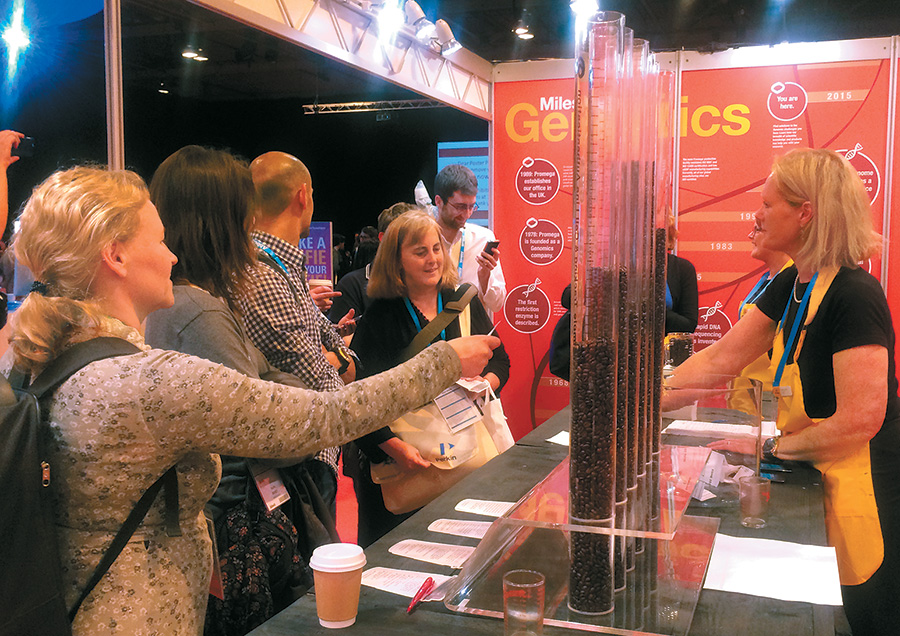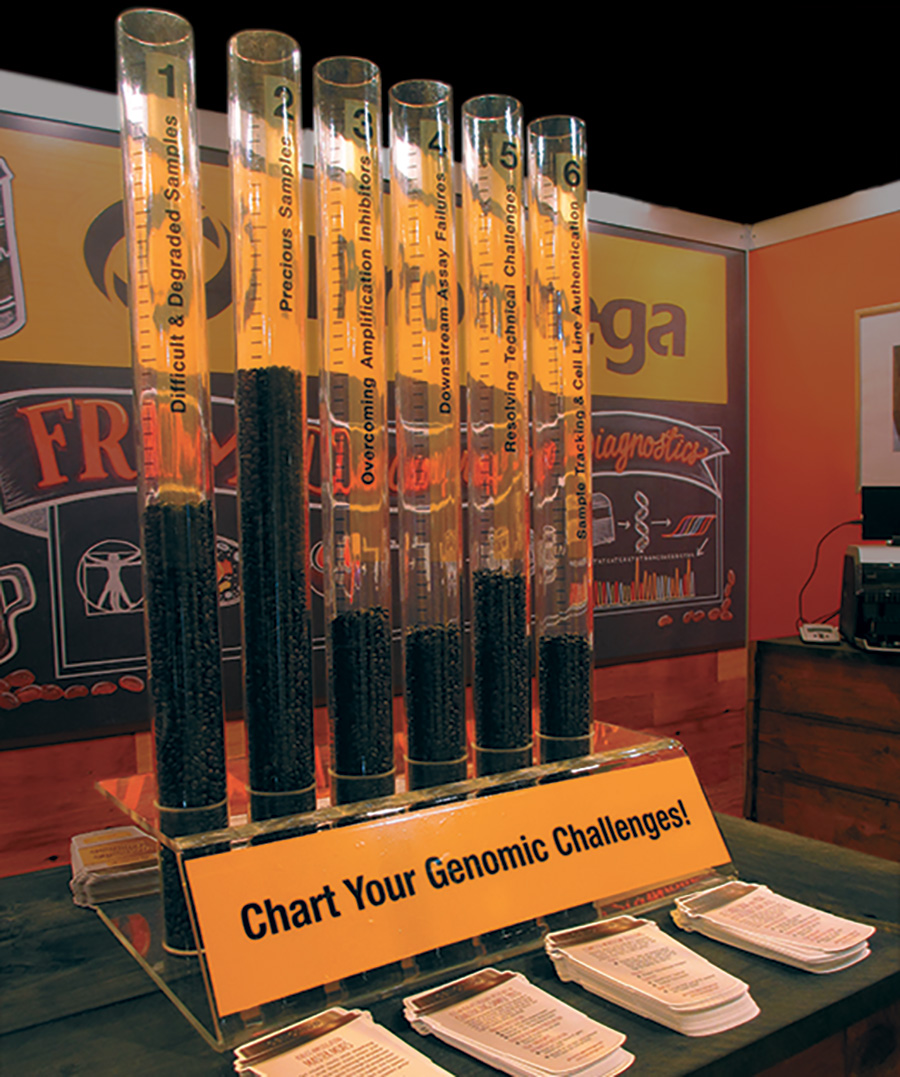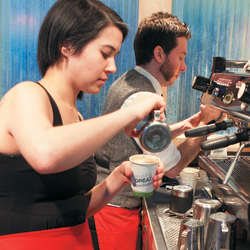|
REGISTRATION REQUIRED
case study

PHOTOS: PROMEGA CORP.
Promega's Strategy of Conversation
By ditching its boring, old exhibit and prioritizing substantive conversations over traditional sales pitches, Promega Corp.
doubles booth traffic and increases qualified trade show leads by 400 percent. By Kelli Billstein
When the human genome was sequenced and mapped in 2003, it was a hailed as a milestone so monumental that some compared it to Neil Armstrong walking on the moon. Since then, the already growing biomedical industry has boomed, and genomics has expanded exponentially. But for Promega Corp., a Madison, WI-based biotechnology company, what was not expanding at the same rapid rate was its exhibit-marketing returns.
Promega's lackluster lead totals were almost paradoxical given the meteoric rise in genomics. After all, President Obama's budget includes a $215 million investment in the Preventative Medicine Initiative, which will fuel biomedical discoveries and hopefully usher in a future for health care that sidesteps trial-and-error treatment and instead embraces targeted medicine. However, if Promega wanted to capitalize on that biomedical momentum, the company would need to more precisely key in on what, exactly, turns trade show attendees into clients. 
Coffee Talk
After some ad hoc internal research, the company identified the one thing that sales reps indicated most consistently led to a highly qualified lead: an engaging, authentic conversation with knowledgeable Promega employees. But in the past, attracting and engaging attendees was more difficult than extracting RNA from a degraded sample. After all, the biotech firm's bare-bones 10-by-10-foot booth wasn't exactly the most welcoming space, and merely handing out generic tchotchkes such as stress balls, pens, and flash drives was not resonating with prospects in any meaningful way.To facilitate conversations inside its 10-by-20-foot booth, Promega Corp. created a coffee-themed campaign that focused on guests' challenges and incentivized engagement. So as the company prepared to exhibit at the 2015 European Society for Human Genetics (ESHG) conference in Glasgow, Scotland, its marketing team sought a way to attract more attention and put those all-important conversations front and center. Grinding out a Concept "We wanted to draw attention in a noncommercial and memorable way that would lend itself to substantive, albeit slightly informal, discussions," says Shaun Peterson, Promega's global strategic marketing manager. "For us, those conversations are extremely important. Promega provides products and services that life scientists need to make headway in their work. And those scientists don't like to be sold to; they prefer to be collaborated with. So while a sales pitch might fall on deaf ears, a simple conversation between a Promega product marketer and a scientist on the verge of a discovery could, indeed, yield incredible results that affect us all." But how does one infuse organic engagement into a corporate exhibit at a serious – and some might say sterile – global genomics conference? The answer, as Promega would suggest, might just be a cup of coffee. "Think about it; what does everyone do in a coffee shop?" Peterson asks. "They talk. They have meaningful conversations." Still, turning a trade show booth into the kind of environment where visitors would feel as at home as they do in their neighborhood Starbucks and as at ease with staffers as they are with their favorite baristas was no small order. 
A Lukewarm Exhibit
"Our goal in designing the exhibit was to create a really warm, friendly environment that would set Promega apart from the other exhibitors and facilitate the kinds of interactions we knew would interest and inspire attendees," says Karen Stakun, Promega's graphic design manager, who turned to the company's corporate campus for inspiration for the exhibit design. "The Promega campus in Madison, WI, is a very welcoming place, and we wanted to echo that vibe on the show floor, while merging it with a coffee-shop concept. And since ESHG 2015 coincided with Promega's 35th anniversary, we wanted to capitalize on that, too."In the past, Promega Corp.'s exhibits were sterile 10-by-10-foot spaces where staffers distributed boring stress balls and forgettable flash drives to uninterested attendees. With that basic aesthetic in mind, Promega's marketing-services department, which functions as the company's in-house exhibit-design agency, started percolating on the idea of modeling the company's exhibit after a campus-inspired coffee shop, while the rest of the team began prepping attendees for what was to come. Brewing Brand Awareness Promega primed attendees for its highly caffeinated exhibit with an email blast that went out two weeks prior to the conference. The missive invited scientists to visit Promega reps at booth 354 to "share their greatest challenges in getting high-quality genomics results" and take part in "a fun interactive café environment." The email also offered coffee-themed incentives to visit the Promega booth, including the chance to win a Nespresso Coffee and Espresso Machine at the end of the conference. Attention was further piqued when attendees picked up their show bags at registration. Inside, they found a curious die-cut flyer in the shape of a paper coffee cup stamped with Promega's logo that read "Genomics Solutions" across the coffee clutch. Below this was a four-digit code along with the words "this could be your lucky number." When attendees flipped over the flyer, they learned that the number could be their key to winning one of 30 glass-beaker coffee mugs if they brought their cups to the Promega exhibit. On the first day of ESHG 2015, attendees approaching booth 354 found a "java-licious" oasis filled with five genomics-savvy staffers dressed as cheerful baristas, whose aprons were emblazoned with the Promega logo. The company's enlarged 10-by-20-foot booth exuded warmth through the use of colors commonly found on the Promega campus – soulful oranges, sunny yellows, and fiery reds. The addition of Erlenmeyer-flask vases with paper flowers inside further warmed the space and suggested this exhibitor had a sense of humor. The 20-foot-long back wall held six 3-by-5-foot chalkboard panels covered with elaborate chalk art typically seen on trendy café menu boards. "We found a great local artist to do the chalkboard art," says Tom Morrison, senior graphic designer at Promega, who art directed the chalkboard portion of the exhibit. But instead of listing pastries and coffee drinks, the signs offered a "solutions menu," which included "reliable DNA and RNA extraction chemistries," "robust amplification master mixes," and "flexible kits and protocols for a variety of sample types."
Good to the Last Drop
Promega Corp.'s redesigned space featured a coffee-shop theme and an assortment of related elements that helped attract attendees, hold their attention, and elicit conversations.
Attendees were intrigued by the coffee-shop booth. It differed dramatically from the other exhibits, which resembled one another in clinical blue, white, and gray hues. "Attendees literally walked right up to us and said, 'What a beautiful booth. It's so different from everything else we've seen today,'" Peterson says. "Then they'd ask what was new with Promega, and the organic conversations we'd been hoping for followed suit." Drinking in Discussions Once attendees were drawn into the booth, staffers slowly led them through the exhibit's open layout, discussing their challenges with genomics studies. On the left interior wall, Promega had created a 9-by-7-foot flow chart illustrating milestones in genetics, which further stimulated conversation. Beyond that, Promega's chalk-art solutions menu got attendees thinking about how the company might serve their needs. Meanwhile, staffers probed for specific problems attendees grappled with in their labs – a conversation that flowed nicely into another chalk-art display, which featured six common challenges scientists face in their work on an almost daily basis. As staffers sussed out attendees' pain points, they led visitors to a custom-built 8-by-3-by-3-foot bar comprising wood planks. Sitting atop the bar were six 3-foot-tall graduated cylinders with a sign below reading "Chart your genomic challenges!" Each cylinder was labeled at the top to represent a different challenge. Information about Promega's solutions to each of those challenges was printed on die-cut handouts in the shapes of coffee cups and stacked below the representative cylinders on the table. Staff invited attendees to take a small scoop of coffee beans from one of the large burlap sacks beside the table and deposit the beans inside the cylinder that represented their greatest hurdle, choosing among options ranging from "difficult and degraded samples" to "downstream assay failures." 
Beans, Beakers, and Bar Charts
"The whole booth encouraged interaction, and human interaction is vital to connection at a show," Peterson says. "I've done a lot of trade shows all over the world, and I can tell you that scientists prefer having these kinds of conversations rather than receiving piles of literature and viewing a display of examples."The graduated cylinders became bean-filled bar charts, allowing attendees to see which of the six challenges posed the most significant obstacles to their peers. After the show, Promega sent emails to participants, revealing the final results of the informal in-booth research. After the coffee-bean activity, staffers gave visitors a complimentary bag of chocolate-covered coffee beans, which were branded with Promega's logo and the words "35 years of expertise with genomics technologies." To register guests for the Nespresso grand prize, staffers collected their contact information and entered it into the drawing. Finally, staffers reminded visitors to return to the Promega booth at the end of the day, when they would randomly select and display 10 numbers that corresponded to codes on the cup-shaped fliers in attendees' registration bags. Those with correspondingly numbered fliers were awarded glass-beaker mugs that proved so popular at ESHG that many nonwinning attendees asked where they could buy one for themselves. Savoring Robust Results "Typically at the trade shows Promega attends, about 25 percent of attendees know who we are and swing by the booth, and maybe 10 percent of those are strong leads. The rest are just looking for swag and giveaways," Peterson says. "We hoped our pre-show promotion and coffee-shop theme would generate greater returns and a higher percentage of interested attendees." Peterson wasn't disappointed. Over the course of the show, staffers had repeat conversations with attendees that stopped by multiple times to see if they'd won a prize or to simply chat with the Promega reps inside the cozy booth. Peterson estimates that attendees spent an average of 15 to 20 minutes conversing inside the exhibit, and roughly 40 percent of those attendees returned a second or third time to continue discussions with company reps.
"This exhibit broke the mold because it was less about products and more about relationship building. Attendees might forget product specs, but the relationships forged through encounters like this are what you remember for the rest of your career."
"Our goal was to lead attendees to water instead of pouring it down their throats," Peterson says. "I think we accomplished that and then some. This exhibit broke the mold because it was less about products and more about relationship building. We began with a question about guests' pain points and avoided hitting them over the head with our company's features and benefits. Attendees might forget product specs, but the relationships forged through encounters like this are what you remember for the rest of your career."Historically, Promega engaged with an average of 250 prospects during ESHG, gathering an average of 50 qualified leads. But the company's coffee-shop booth attracted 500 prospective clients, including 250 that were deemed highly qualified. Compared to Promega's metrics from the previous year, that's a whopping 100-percent increase in booth traffic, and an incredible 400-percent uptick in qualified leads. It's safe to say that Promega reintroduced itself to the genomics community and left a lasting buzz. After the show ended and the coveted Nespresso coffee machine was given away, Promega followed up with attendees who had participated in the coffee-bean activity, sending an email thanking them for contributing to the informal research effort and revealing the final results of the activity. For scientists who get giddy around genomic data, it was interesting to learn the top challenges their colleagues faced. Furthermore, the post-show communique reminded recipients that no matter which of the six challenges were most daunting to them, Promega had a solution to help them overcome it. Ultimately, a soft-sell, relationship-building approach was such a fruitful shift in strategy that Promega has gone on to use its themed exhibit at two significant conferences since ESHG 2015. It just goes to show that sometimes a coffee break can lead to much more than a just an espresso buzz; it can generate some serious business buzz, too. E 
|
|
|||||||||||||||||||||||
|
||||||||||||||||||||||||||||
|
|
||||||||||||||||||||||||||||
|
TOPICS Measurement & Budgeting Planning & Execution Marketing & Promotion Events & Venues Personal & Career Exhibits & Experiences International Exhibiting Resources for Rookies Research & Resources |
MAGAZINE Subscribe Today! Renew Subscription Update Address Digital Downloads Newsletters Advertise |
FIND IT Exhibit Producers Products & Services All Companies Get Listed |
EXHIBITORLIVE Sessions Exhibit Hall Exhibit at the Show Registration |
ETRAK Sessions Certification F.A.Q. Registration |
EDUCATION WEEK Overview Sessions Hotel Registration |
CERTIFICATION The Program Steps to Certification Faculty and Staff Enroll in CTSM Submit Quiz Answers My CTSM |
AWARDS Exhibit Design Awards Portable/Modular Awards Corporate Event Awards Centers of Excellence |
NEWS Associations/Press Awards Company News International New Products People Shows & Events Venues & Destinations EXHIBITOR News |
||||||||||||||||||||
|
||||||||||||||||||||||||||||












